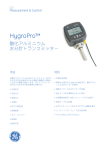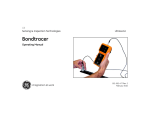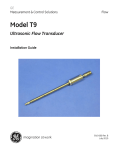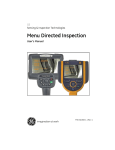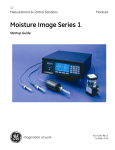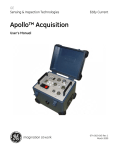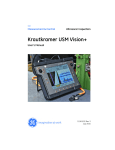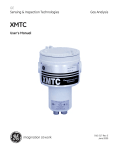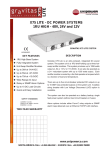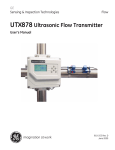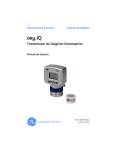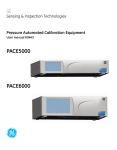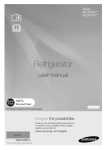Download HygroPro - GE Measurement & Control
Transcript
GE Sensing & Inspection Technologies HygroPro Moisture Transmitter User’s Manual 916-099C October 2008 GESensingInspection.com ©2008 General Electric Company. All rights reserved. Technical content subject to change without notice. GE Sensing & Inspection Technologies HygroPro Moisture Transmitter User’s Manual ©2008 General Electric Company. All rights reserved. Technical content subject to change without notice. 916-099C October 2008 Page 1 Contents Chapter 1: Installation 1.1 Introduction . . . . . . . . . . . . . . . . . . . . . . . . . . . . . . . . . . . . . . . . . .5 1.2 Sample System Guidelines . . . . . . . . . . . . . . . . . . . . . . . . . . . . . .6 1.3 Mounting the Transmitter . . . . . . . . . . . . . . . . . . . . . . . . . . . . . . .8 1.4 Wiring the Transmitter . . . . . . . . . . . . . . . . . . . . . . . . . . . . . . . . .9 1.4.1 Standard Wiring Connections . . . . . . . . . . . . . . . . . . . . . .10 1.4.2 Hazardous Area Wiring Connections . . . . . . . . . . . . . . . .15 Chapter 2: Operation 2.1 Powering Up & Programming. . . . . . . . . . . . . . . . . . . . . . . . . . .23 2.1.1 Menu Map . . . . . . . . . . . . . . . . . . . . . . . . . . . . . . . . . . . . .24 2.1.2 Keypad. . . . . . . . . . . . . . . . . . . . . . . . . . . . . . . . . . . . . . . .25 2.2 Basic Setup . . . . . . . . . . . . . . . . . . . . . . . . . . . . . . . . . . . . . . . . .25 2.2.1 Unlocking the Display . . . . . . . . . . . . . . . . . . . . . . . . . . . .25 2.2.2 Entering the Setup Program. . . . . . . . . . . . . . . . . . . . . . . .26 2.2.3 Selecting Measurement Parameters. . . . . . . . . . . . . . . . . .27 2.2.4 Setting Up the Display. . . . . . . . . . . . . . . . . . . . . . . . . . . .29 2.2.5 Setting Up the Analog Output . . . . . . . . . . . . . . . . . . . . . .30 2.2.6 Entering the Node ID. . . . . . . . . . . . . . . . . . . . . . . . . . . . .32 2.2.7 Setting Up the RS485 Output . . . . . . . . . . . . . . . . . . . . . .33 2.3 Advanced Setup. . . . . . . . . . . . . . . . . . . . . . . . . . . . . . . . . . . . . .34 2.3.1 Setting Up the Pressure/Temperature Displays . . . . . . . . .34 2.3.2 Entering Sensor Calibration Data . . . . . . . . . . . . . . . . . . .35 2.3.3 Locking and Unlocking the Keypad . . . . . . . . . . . . . . . . .37 2.3.4 Locking and Unlocking the Menus . . . . . . . . . . . . . . . . . .37 HygroPro User’s Manual Page 3 Contents Chapter 3: Service & Maintenance 3.1 The Service Menus . . . . . . . . . . . . . . . . . . . . . . . . . . . . . . . . . . 39 3.2 Moisture Probe Error Conditions. . . . . . . . . . . . . . . . . . . . . . . . 40 3.3 Cleaning the Moisture Probe . . . . . . . . . . . . . . . . . . . . . . . . . . . 40 3.3.1 Preparing to Clean the Probe . . . . . . . . . . . . . . . . . . . . . . 40 3.3.2 Replacing the RTE . . . . . . . . . . . . . . . . . . . . . . . . . . . . . . 41 3.3.3 Removing the Transmitter from the System . . . . . . . . . . 42 3.3.4 Removing the Probe from the Transmitter. . . . . . . . . . . . 42 3.3.5 Cleaning the Sensor and the Shield . . . . . . . . . . . . . . . . . 44 3.3.6 Installing the Probe in the Transmitter . . . . . . . . . . . . . . . 45 3.3.7 Evaluating the Cleaned Probe . . . . . . . . . . . . . . . . . . . . . 45 Chapter 4: Specifications 4.1 General. . . . . . . . . . . . . . . . . . . . . . . . . . . . . . . . . . . . . . . . . . . . 47 4.2 Electrical . . . . . . . . . . . . . . . . . . . . . . . . . . . . . . . . . . . . . . . . . . 48 4.3 Mechanical. . . . . . . . . . . . . . . . . . . . . . . . . . . . . . . . . . . . . . . . . 49 4.4 Moisture Sensor . . . . . . . . . . . . . . . . . . . . . . . . . . . . . . . . . . . . . 50 4.5 Built-In Temperature Sensor . . . . . . . . . . . . . . . . . . . . . . . . . . . 50 4.6 Built-In Pressure Sensor . . . . . . . . . . . . . . . . . . . . . . . . . . . . . . 51 4.7 Certifications . . . . . . . . . . . . . . . . . . . . . . . . . . . . . . . . . . . . . . . 52 Page 4 HygroPro User’s Manual Chapter 1: Installation 1.1 Introduction The HygroPro Moisture Transmitter is a compact, intrinsically-safe, loop-powered, 4-20 mA transmitter that provides accurate dew/frost point measurements over a range of –110 to 20°C (-166 to 68°F). It features an integrated display and a six-button keypad, and it is housed in an IP67/Type 4X enclosure. The HygroPro transmitter uses an aluminum oxide moisture sensor, and it includes a temperature thermistor and a pressure transducer on a common mount for calculation of parameters such as: • ppmv in gases • ppmw in liquids • pounds per million standard cubic feet in natural gas • process relative humidity. IMPORTANT: To install the HygroPro in a hazardous (classified) area, see Hazardous Area Wiring Connections on page 15. HygroPro User’s Manual Page 5 Chapter 1: Installation 1.2 Sample System Guidelines The HygroPro transmitter can be installed in a sample system or directly in the process line. However, GE recommends that the unit be installed in a sample system to protect the probe from potentially damaging components in the process stream. Figure 1 below shows a typical sample system. Flow HygroPro Needle Valve 1 Probe Needle Valve 2 Intake near the center of the pipe is recommended. Flow Cell See note below Figure 1: A Typical Sample System Note: At least 5 ft (1.5 m) of 1/4” (6 mm) tubing vented to atmosphere will ensure an accurate process sample and avoid diffusion of ambient air moisture back into the process. Page 6 HygroPro User’s Manual Chapter 1: Installation 1.2 Sample System Guidelines (cont.) In the sample system shown in Figure 1 on the previous page, fully open Valve 1 and use Valve 2 to regulate the sample flow for measurements at process system pressure. For measurements at atmospheric pressure, fully open Valve 2 and use Valve 1 to regulate the sample flow. Before constructing a sample system, consult a GE application engineer and observe the following guidelines: • The sample system should be very simple and should contain as few components as possible. All or most of those components should be located downstream of the measurement point. • Sample system components must not affect moisture readings. Most common filters and pressure regulators are not suitable for sample systems because the wetted parts adsorb moisture or release moisture into the sample system. They may also allow ambient contamination to enter the sample system. If possible, use stainless steel for all wetted parts. • The HygroPro probe should be oriented perpendicular to the sample system inlet. For dimensions and other sample system requirements see Mechanical Specifications on page 46. • Sample systems should be tested for leaks prior to operation, using a Snoop leak detector, to verify the integrity of connections, components and fittings. IMPORTANT: When pressurizing or depressurizing the sample system, be careful to avoid shock damage to the moisture sensor. HygroPro User’s Manual Page 7 Chapter 1: Installation 1.3 Mounting the Transmitter !CAUTION! If the HygroPro will be installed directly into the process line, consult GE for proper installation instructions and precautions before proceeding. Refer to Figure 2 below and complete the steps on the next page to install the HygroPro transmitter. Probe Hex Nut 3/4-16 UNF-2A Shield Figure 2: HygroPro Installation Page 8 HygroPro User’s Manual Chapter 1: Installation 1.3 Mounting the Transmitter (cont.) 1. Make sure the sintered or stainless-steel shield is in place over the sensor. This shield protects the aluminum oxide sensor from damage during operation. 2. Using the integral 3/4-16 straight male thread, screw the probe end of the transmitter into the process or sample system fitting. Make sure not to damage the threads. Note: A 3/4-16 to G 1/2 thread adapter is available from GE. 3. Using a 1-1/8” wrench on the probe hex nut, tighten the probe securely into the process or sample system fitting. !CAUTION! Do not apply torque to the transmitter electronic module to tighten the unit into its fitting. Note: If there is insufficient space to rotate the HygroPro during installation, remove the Replaceable Transducer Element (RTE) from the transmitter, install it in the fitting, then re-install the the transmitter onto the RTE. 1.4 Wiring the Transmitter Proceed to the appropriate section for instructions on: • Standard Wiring Connections (proceed to next page) • Hazardous Area Wiring Connections (proceed page 15) HygroPro User’s Manual Page 9 Chapter 1: Installation 1.4.1 Standard Wiring Connections The HygroPro is a 4-20 mA loop-powered device that can use the same two wires for its measurement signal lines and its power supply lines. Follow the instructions in this section only for units not requiring hazardous (classified) area protection. IMPORTANT: To install the HygroPro in a hazardous (classified) area, see Hazardous Area Wiring Connections on page 15. The transmitter must be wired using the factory-supplied, 2-meter cable. If a different cable length is required, please contact the factory for assistance. Note: If a longer cable is required, you may splice an extension onto the standard cable. Be sure to connect leads of the same color together. For example, connect blue lead to blue lead, brown lead to brown lead, etc. The HygroPro may be connected to either of the following types of external systems: • an external device that can provide the loop power to the HygroPro and can also receive and display the 4-20 mA measurement output from the HygroPro (proceed to next page) • an external power supply to provide power to the HygroPro plus a personal computer (PC) running GE’s PanaView™ interface software (proceed to page 13) Page 10 HygroPro User’s Manual Chapter 1: Installation 1.4.1a Standard Connections - Without a PC IMPORTANT: To install the HygroPro in a hazardous (classified) area, see Hazardous Area Wiring Connections on page 15. Refer to Figure 3 on the next page and Table 1 below, and complete the following steps to wire the transmitter. Table 1: Cable Leads - Without a PC Lead Connection Description Blue Power Supply (+) [12-28 VDC] Brown Power Supply (–) [Return] Shield Earth Ground [recommended] 1. Push the female connector end of the factory-supplied cable into the mating male connector on the transmitter module. Make sure the pins are properly aligned. Then, secure the connectors together by sliding the metal sleeve on the cable over the connectors and turning it clockwise until it is tight. 2. Using the flying leads at the other end of the factory-supplied cable, connect the transmitter to the external system. Note: The blue and brown leads also carry the measurement signal current output of 4-20 mA. 3. Trim any unused leads even with the outer cable jacket to remove any bare wire and prevent accidental short circuits. HygroPro User’s Manual Page 11 Chapter 1: Installation 1.4.1a Standard Connections - Without a PC (cont.) Shield brown Return 12-28 VDC blue + – Power and Measurement Circuits Earth Ground Figure 3: Standard Connections - Without a PC Page 12 HygroPro User’s Manual Chapter 1: Installation 1.4.1b Standard Connections - With a PC IMPORTANT: To install the HygroPro in a hazardous (classified) area, see Hazardous Area Wiring Connections on page 15. Refer to Figure 4 on the next page and Table 2 below, and complete the following steps to wire the transmitter. Lead Table 2: Cable Leads - With a PC Connection Description Blue Power Supply (+) [12-28 VDC] Brown Power Supply (–) [Return] White RS485-RS232 Converter (+) [positive] Black RS485-RS232 Converter (–) [negative] Ground Earth Ground 1. Connect an RS485-RS232 converter (customer-supplied) to an available serial port on the PC. 2. Push the female connector end of the factory-supplied cable into the mating male connector on the transmitter module. Make sure the pins are properly aligned. Then, secure the connectors together by sliding the metal sleeve on the cable over the connectors and turning it clockwise until it is tight. 3. Using the flying leads at the other end of the factory-supplied cable, connect the transmitter to the external system. 4. Trim any unused leads even with the outer cable jacket to remove any bare wire and prevent accidental short circuits. HygroPro User’s Manual Page 13 Chapter 1: Installation 1.4.1b Standard Connections - With a PC (cont.) Power Supply 24 VDC Earth Ground Brown – – Black + White Blue + RS485 – RS232 Converter Box RS232 PanaView Figure 4: Standard Connections - With a PC Page 14 HygroPro User’s Manual Chapter 1: Installation 1.4.2 Hazardous Area Wiring Connections Before installing and using the HygroPro in a hazardous (classified) area, be sure to read and understand all applicable reference materials. This includes: • all EU or North American Standards and Directives (see Table 3 and Table 4 on page 17) • all local safety procedures and practices • the FM Schematic drawing (see Figure 5 on the next page) • this user’s manual Note: It is the installer’s responsibility to follow all applicable standards and procedures. !WARNING! The procedures in this section must be performed only by trained technicians who have the necessary skills and qualifications. HygroPro User’s Manual Page 15 Page 16 black white blue brown Use cable P/N 230-049-01 3. Galvanically Isolated FM Approved (US) or Canadian Certified (for Canada) associated apparatus installed in accordance with the manufactruer's instructions. 2. The subject equipment is FM Approved, and FM Approved for Canada for the following Hazardous (Classified) Locations and Protection Methods: Intrinsically Safe, Class I, II, III, Division 1, Group ABCDEFG, T4 T Ambient: -40 C to 60 C Enclosure: IP 67 1. Installation shall be in accordance with the National Electrical Code (ANSI/NFPA 70) or Part One of the Canadian Electrical Code (C221), as applicable. Notes: RS485 Comm Terminal Safety Entity Parameters: Vmax = 3.72 V Imax = 228 mA Pi = 212 mW Ci = 0 Li = 62 uH Loop Terminal Safety Entity Parameters: Vmax = 28 V Imax = 93.3 mA Pi = 0.653 W Ci = 0 Li = 62 uH HygroPro Hazardous or Non-Hazardous Location Class I, Division 1, Group ABCD Class II, Division 1, Group EFG Class III, Division 1 RS485 Comm Note 4 Loop-Power Device Note 4 5. Maintain the following relationship between Intrinsic Safety (Entity) Parameters of HygroPro and associated apparatus: HygroPro Vmax > associated apparatus Voc HygroPro Imax > associated apparatus Isc HygroPro Pi > associated apparatus Po HygroPro Ci + Ccable < associated apparatus Ca HygroPro Li + Lcable < associated apparatus La 4. Equipment to which associated apparatus is connected shall not use or generate in excess of 250V. Associated Apparatus Note 3 Associated Apparatus Note 3 Non-Hazardous Location Chapter 1: Installation 1.4.2 Hazardous Area Wiring Connections (cont.) Figure 5: FM Schematic (ref. dwg #752-262) HygroPro User’s Manual Chapter 1: Installation 1.4.2a Applicable Standards and Directives When the HygroPro is installed in hazardous areas with potentially explosive atmospheres, it complies with the ATEX directive 94/9/EC, the EU standards listed in Table 3 below, and the North American FM/CSA and IEC standards listed in Table 4 below. Table 3: European Union (EU) Standards Title Number General requirements Intrinsic safety “i” Group II, Category 1G, Zone 0 equipment Date EN 60079-0 2000 EN 50020 2002 EN 60079-26 2004 Table 4: North American Standards Title Number Date Class No. 3600 Nov. 1998 Intrinsically Safe Apparatus and Associated Class No. 3610 Apparatus for use in Class I, II, & III, Division 1, and Class I, Zone 0 & 1 Hazardous (Classified) Locations Oct. 1999 Electrical Equipment for Measurement, Control and Laboratory Use Class No. 3810 Jan. 2005 Intrinsically Safe and Non-incendive Electrical for Use in Hazardous Locations CSA-C22.2 No. 157 1992, Reaffirmed 2002 Safety Requirements for Electrical Equipment for Measurement, Control, and Laboratory Use - Part 1: General Requirements (Adopted IEC 61010-1:2001, MOD) (Tri-National standard, with UL 61010-1 and ISA 82.02.01) CSA-C22.2 No. 61010-1 July 2004 Degrees of Protection Provided by Enclosures (IP Code) ANSI/IEC 60529 2004 Degrees of Protection Provided by Enclosures (IP Code) CSA-C22.2 No. 60529 2005 Electrical Equipment for Use in Hazardous (Classified) Locations General Requirements HygroPro User’s Manual Page 17 Chapter 1: Installation 1.4.2b Compliance Requirements The HygroPro installation must comply with EN 60079-14 in Europe and with the National Electrical Code (ANSI/NFPA 70) or part one of the Canadian Electrical Code (C22.1), as applicable, in North America. In other regions, additional local codes may also apply. 1.4.2c Electrical Connections The HygroPro transmitter is certified intrinsically-safe for use in zone 0. However, the external power must be provided by one of the following methods: • an isolated, intrinsically-safe, 24 VDC power supply mounted in the safe area • an isolated zener barrier mounted in the safe area and installed between a standard 24 VDC power supply and the HygroPro Refer to Figure 6 on the next page for a typical hazardous (classified) area HygroPro wiring diagram. This installation uses an MTL706 zener barrier, in accordance with the second option listed above. If using serial communications with a PC, an isolated RS232-RS485 converter mounted in the safe area between the computer and HygroPro must be used. The converter is typically powered by its own standard 24 VDC power supply. !WARNING! Do NOT power an RS232-RS485 converter from the same intrinsically-safe 24 VDC power supply used to power the HygroPro. Page 18 HygroPro User’s Manual Chapter 1: Installation 1.4.2c Electrical Connections (cont.) Figure 6: Hazardous Area Connections HygroPro User’s Manual Page 19 Chapter 1: Installation 1.4.2d Requirements for External Devices When connecting the HygroPro to external devices, the allowable total load capacitance and inductance for those devices are listed in the manufacturer’s datasheets. The entity parameters of the external devices (e.g. voltage, current and power) must be equal to or lower than the same specifications for the HygroPro. The entity parameters for the HygroPro are listed in Table 5 below. Table 5: HygroPro Entity Parameters Loop Power Supply Ui = 28 V Pi = 0.653 W Ii = 93.3 mA Ci = 0 Li = 62 µH RS485 Digital Output Ui = 3.72 V Pi = 212 mW Ii = 228 mA Ci = 67 µF at 5.36 V Page 20 Li = 62 µH HygroPro User’s Manual Chapter 1: Installation 1.4.2e Special Conditions for Safe Operation The “X” at the end of the HygroPro ATEX certificate number, Bas06ATEX0019X, indicates that special conditions are required for safe operation in Europe. These conditions are: 1. The equipment must be protected against impact or friction with ferrous metals. 2. The bare ends of the connecting cable must be terminated in such a way that the terminations are afforded a degree of protection of not less than IP20 ingress protection. 3. The HygroPro is incapable of withstanding the 500 VAC test between all inputs and frame for one minute. Therefore, the HygroPro must be earthed by connecting the outer grounding screw on the HygroPro with the equipotential bonding system. Follow the local standards and electrical codes regarding the equipotential bonding system. !WARNING! Never connect or disconnect the HygroPro in the hazardous area when supply power or the communication circuit is energized. Isolate the supply lines in the non-hazardous area first. Following the same special conditions listed above is recommended for regions outside of Europe as well. HygroPro User’s Manual Page 21 Chapter 1: Installation Page 22 HygroPro User’s Manual Chapter 2: Operation 2.1 Powering Up & Programming After the HygroPro has been installed as described in Chapter 1, Installation, power may be applied to the unit. The transmitter requires up to 60 seconds to initialize and begin normal operation. The unit will meet its specified accuracy within 3 minutes. Figure 7 below shows a close-up view of the HygroPro display and keypad, and Figure 8 on the next page shows a complete menu map of the HygroPro setup program. Figure 7: HygroPro Display and Keypad HygroPro User’s Manual Page 23 Page 24 Trim Range Type C Mode % Span Trim Base Trim Span Zero Special NAMUR 4-20mA Pressure FP [22 options] Hygro Normal Test Span CS Table Press Curve Contrast 3 Measure Live Constant Hygro Curve Const Pressure Normal Calibrate Reverse Zero Output Passcode 2 Display unlock - [enter] [escape] - [enter] - [escape] 1 # of Views Startup Screen Row 1 CS 6 Temp CS 1 Temp C6 C1 Span PSIg Span mV Zero PSIg Zero mV Units 16 Row 16 Units 1 Constant Live Const Temperature Lock Keypad Save Table? Data Bits Stop Bits Parity Baud Rate Node ID Lock Menus 8 7 2 1 Odd Even None Upgrade Default Analyzer 9600 Versions Service* 4800 2400 RS485 * Factory-level passcode is required to access the Service menu. Chapter 2: Operation 2.1.1 Menu Map Figure 8: Programming Menu Map HygroPro User’s Manual Chapter 2: Operation 2.1.2 Keypad After entering the setup program, the keys on the HygroPro keypad (see Figure 7 on page 23) perform the following functions: • enter - confirm a selection or move to the next screen • escape - cancel a selection or move to the previous screen • up - scroll upward through a list of options or increase the value of a selected character • down - scroll downward through a list of options or decrease the value of a selected character • left - move the cursor to the next character to the left • right - move the cursor to the next character to the right 2.2 Basic Setup The HygroPro transmitter is easily programmed to meet the user’s requirements by referring to the menu map in Figure 8 on the previous page and following the instructions in this section. 2.2.1 Unlocking the Display Upon startup, the following screen appears on the HygroPro display: The symbol in the upper right corner indicates that the screen is locked. To unlock the screen, press 8 9 8 escape, enter, escape. HygroPro User’s Manual Page 25 Chapter 2: Operation 2.2.2 Entering the Setup Program To enter the setup program, complete the following steps: Using the arrow keys, highlight the opened lock and press enter. Select Passcode and press enter. Note: The default operator-level passcode is 2719. Enter your passcode using the up and down keys to change the value of each passcode digit, and the left and right keys to move from one digit to the next. When the passcode is correct, press enter. Note: To enter the Service menu, the factory-level passcode must be entered. Page 26 HygroPro User’s Manual Chapter 2: Operation 2.2.3 Selecting Measurement Parameters To select the measurement parameters, complete the following steps: To select the number of measurements to be displayed on each screen, select # of Views and press enter. Use the up and down keys to select the number of views desired and press enter. Then, press enter again to return to the previous menu. Press escape to see the view setup. To change a measurement parameter, use the arrow keys to highlight the parameter name and then press enter. Use the up and down arrow keys to select a measurement parameter and then press enter twice. Note: As an example, Dew Point has been selected as the measurement parameter to be changed. HygroPro User’s Manual Page 27 Chapter 2: Operation 2.2.3 Selecting Measurement Parameters (cont.) Use the up and down arrow keys to select a unit of measure and press enter twice. Repeat the previous steps to make any other desired measurement parameter changes. Then, continue as follows: • If the operator-level passcode was used, highlight the lock symbol and press enter again to return to the DISPLAY menu. • If the service-level passcode was used, continue the programming steps below. If the number of decimal places is acceptable, press escape. To change the number of decimal places, press enter. Use the up and down keys to change the number of decimal places and press enter. The programming sequence is now complete and you are returned to the View menu. Page 28 HygroPro User’s Manual Chapter 2: Operation 2.2.4 Setting Up the Display To set up the display, complete the following steps: Use the up and down keys to select Display and press enter. Then, enter your passcode and press enter. Use the up and down keys to select Display and press enter. If the display type is acceptable, press escape to return to the previous menu. To change the display type, use the up and down keys to select Normal or Reverse and press enter. If you wish to change the display Contrast, at the above screen, highlight that choice and press enter. Use the arrow keys to change the Contrast value and press enter. Then press escape twice to return to the main menu. HygroPro User’s Manual Page 29 Chapter 2: Operation 2.2.5 Setting Up the Analog Output To set up the analog output, complete the following steps: After entering your password, use the right arrow key to scroll to Output and press enter. Select the Measure option and press enter. Use the arrow keys to scroll to the desired output parameter and press enter. In the Output menu, select Type and press enter. The following screen appears: Select the desired output Type and press enter. Page 30 HygroPro User’s Manual Chapter 2: Operation 2.2.5 Setting Up the Analog Output (cont.) If Special was chosen at the previous prompt, the following screen appears: Select Zero and press enter. Use the arrow keys to enter the zero value for the special output and press enter. Repeat the above two steps to enter the Span value for the special output. In the Output menu, select Range and press enter. The following screen appears: Enter the Zero and Span values for the range, using the same procedure as above. HygroPro User’s Manual Page 31 Chapter 2: Operation 2.2.5 Setting Up the Analog Output (cont.) In the Output menu, select Trim and press enter. The following screen appears: Enter your values for the Base Trim, Span Trim and %, using the same procedures as on the previous page. When you select the Mode option at the above prompt, choose either Test to verify the output or Normal for normal operation. 2.2.6 Entering the Node ID The Node ID is a unique network identifier that enables the HygroPro to be connected to a multi-drop network when used with PanaView™ interface software. To enter your Node ID, proceed as follows: Enter your passcode to access the setup program. Then use the arrow keys to select the Node ID menu. Press enter. Use the arrow keys to enter the desired Node ID value and press enter. Page 32 HygroPro User’s Manual Chapter 2: Operation 2.2.7 Setting Up the RS485 Output To set up the RS485 output, complete the following steps: Enter your passcode to access the setup program. Then use the arrow keys to select the RS485 menu. Press enter. To enter the Baud Rate, press enter. Use the up and down keys to select the desired value and press enter. Repeat the above procedure to enter the following RS485 parameters: • Parity • Stop Bits • Data Bits You have now completed the initial setup process. HygroPro User’s Manual Page 33 Chapter 2: Operation 2.3 Advanced Setup The following sections describe the procedures for completing the configuration of your HygroPro transmitter. 2.3.1 Setting Up the Pressure/Temperature Displays The following steps set the displayed pressure and temperature values to Live (changing with the current measurements) or Constant (remaining the same, regardless of the current measurements). If Constant is selected, the desired numerical value must be set. To set the pressure display, enter your password and use the arrow keys to select Const Pressure. Press enter. Use the arrow keys to select either Live Pressure or Constant Pressure and press enter. If you selected Constant Pressure, use the arrow keys to select Press... and press enter. Use the arrow keys to enter the desired pressure value and press enter. The screen will be updated to show the new pressure value. Page 34 HygroPro User’s Manual Chapter 2: Operation 2.3.1 Setting Up the Pressure/Temperature Displays (cont.) To set the temperature display, enter your password and use the arrow keys to select Const Temperature. Press enter. Use the same procedure to set the temperature mode, and if Constant Temperature is selected, to enter the constant temperature value. 2.3.2 Entering Sensor Calibration Data Enter your password and use the arrow keys to scroll to Calibrate. Press enter. Select Hygro Curve and press enter. Select Row1 and press enter. HygroPro User’s Manual Page 35 Chapter 2: Operation 2.3.2 Entering Sensor Calibration Data (cont.) Select the desired units and press enter. Use the arrow keys to enter a value and press enter. Repeat the previous steps until all of your Hygro Curve data points have been entered. To save the data you have entered, scroll to the bottom of the Hygro Curve options list to the SAVE HYGRO TABLE? section. Then, select Save and press enter. IMPORTANT: Any data not saved at the above prompt will be lost. Repeat the above process to enter any available Press Curve and CS Table data points. Note: The CS Table is required only if ppmw measurements will be made. Consult GE for the table values to use for your application. Page 36 HygroPro User’s Manual Chapter 2: Operation 2.3.3 Locking and Unlocking the Keypad To lock the keypad to prevent it from being used, enter the user program as described on page 26. Use the down arrow key to select Lock Keypad on the initial screen and press enter twice. The keypad is now locked. To unlock the keypad, just re-enter the user program as described on page 26. No further programming steps are required. 2.3.4 Locking and Unlocking the Menus To lock the menus to prevent them from being changed, enter the user program as described on page 26. Use the down arrow key to select Lock Menus on the initial screen and press enter twice. The menus are now locked. To unlock the menus, just re-enter the user program as described on page 26. No further programming steps are required. HygroPro User’s Manual Page 37 Chapter 2: Operation Page 38 HygroPro User’s Manual Chapter 3: Service & Maintenance 3.1 The Service Menus IMPORTANT: The service menus are accessible only by using the factory-level passcode. After entering the Factory Level passcode, use the arrow keys to scroll to Service and press enter. To check the version levels of your HygroPro firmware, select Versions and press enter. The information for your unit is displayed. The following HygroPro service menu options are also available: • Upgrade - used to install an updated firmware version • Default Analyzer - used to reset all settings to the factory defaults Select the desired Service menu option and press enter. Then, follow the on-screen instructions. After completing the above step, respond to the ARE YOU SURE? question. Be sure to respond Yes, if you wish to save the new information. HygroPro User’s Manual Page 39 Chapter 3: Service & Maintenance 3.2 Moisture Probe Error Conditions IMPORTANT: All moisture probes require periodic cleaning to maintain optimum accuracy. Consult the GE service center for the recommended probe cleaning interval for your application. If there is a problem with the moisture probe during operation, the HygroPro is programmed to indicate the error condition via its analog output signal. To indicate a probe error condition, the analog output signal is forced to the following values: • ≥ 22 mA to indicate a short circuit in the probe • ≤ 3.5 mA to indicate an open circuit in the probe If you have one of the above error conditions, follow the probe cleaning instructions in the next section. 3.3 Cleaning the Moisture Probe To clean your HygroPro moisture probe, carefully follow the instructions in this section. 3.3.1 Preparing to Clean the Probe CAUTION! Be sure to perform the probe cleaning procedure in a well-ventilated area. Observe all necessary safety precautions when handling the cleaning solvents Page 40 HygroPro User’s Manual Chapter 3: Service & Maintenance 3.3.1 Preparing to Clean the Probe (cont.) To clean the moisture probe, the following items are required: • Two glass (NOT metal) containers with approximately 300 ml of reagent-grade hexane or toluene in each container. • One glass (NOT metal) container with approximately 300 ml of distilled (NOT deionized) water. IMPORTANT: Make sure the containers are deep enough to completely submerge the moisture probe. Do not place the transmitter module into the solvents. Insert only the moisture sensor into the solvents. • Rubber or latex gloves • An oven set at 50°C ± 2°C (122°F ± 3.6°F) • 1-1/8” wrench 3.3.2 Replacing the RTE To maximize HygroPro performance, GE recommends recalibration of the aluminum oxide moisture sensor on the Replaceable Transducer Element (RTE) every 6 to 12 months. The optimum interval depends on the specific application. To accomplish this, either return the RTE to GE for recalibration or install a new RTE. The HygroPro electronics will automatically read and store the calibration data whenever a new or recalibrated RTE is installed. IMPORTANT: The programmed probe calibration data should not be changed without consulting GE. HygroPro User’s Manual Page 41 Chapter 3: Service & Maintenance 3.3.3 Removing the Transmitter from the System Complete the following steps to remove the transmitter from the installation site: 1. Refer to Figure 2 on page 8 and use a 1-1/8” wrench on the probe hex nut to unthread the transmitter from the fitting on the sample system or process line. 2. Record the dew point of the ambient air. 3. Disconnect the cable from the transmitter module. 3.3.4 Removing the Probe from the Transmitter To remove the probe from the transmitter, refer to Figure 9 on the next page and proceed as follows: 1. Loosen the four captive screws on the bottom of the transmitter. 2. Carefully remove the metal plate without touching the sensor. 3. Carefully pull the probe out of the transmitter. 4. Disconnect the probe cable by turning the locknut at the top of the probe. Then, detach the sensor. Page 42 HygroPro User’s Manual Chapter 3: Service & Maintenance 3.3.4 Removing the Probe from the Transmitter (cont.) Cable Locknut Probe Metal Plate Captive Screws Figure 9: Removing the Probe from the Transmitter HygroPro User’s Manual Page 43 Chapter 3: Service & Maintenance 3.3.5 Cleaning the Sensor and the Shield CAUTION! Do not place the transmitter module into the solvents. Insert only the sensor portion of the instrument. Do not allow the sensor to come into contact with the surfaces of cleaning containers or with any other hard surface. 1. While wearing protective gloves, place the sensor in the first container of hexane or toluene and allow it to soak for 10 minutes. 2. Remove the sensor from the hexane or toluene and soak it in the container of distilled water for 10 minutes. 3. Remove the sensor from the distilled water and soak it in the second (clean) container of hexane or toluene for 10 minutes. 4. Remove the sensor from the hexane or toluene and set it aside in a clean area. 5. Repeat steps 1 to 3 to clean the shield. To ensure the removal of any contaminants that may have become embedded in the porous walls of the shield, swirl the shield in the solvents during the soaking procedure. 6. Remove the shield from the hexane or toluene. 7. Carefully replace the shield over the exposed sensor without touching the sensor. 8. Place the sensor with the installed shield in an oven set at 50°C ± 2°C (122°F ± 3.6°F) for 24 hours. Page 44 HygroPro User’s Manual Chapter 3: Service & Maintenance 3.3.6 Installing the Probe in the Transmitter To install a new or cleaned probe in the transmitter, complete the following steps: 1. Reconnect the probe cable to the top of the probe by turning the locknut. 2. Carefully push the probe into the transmitter. 3. Replace the metal plate without touching the sensor. 4. Tighten the four captive screws on the metal plate into the bottom of the transmitter. 3.3.7 Evaluating the Cleaned Probe Note: All new probes are calibrated at the factory, and no evaluation is required after installation. 1. Reconnect the probe cable to the transmitter module and measure the ambient air dew point. Make sure to measure the same ambient air as measured during removal of the transmitter. 2. Compare the two ambient air readings. If the new ambient air reading is within ±2°C (±3.6°F) of the first reading, the cleaned probe is properly calibrated and normal operation may be resumed. 3. If the probe is still not reading the ambient air accurately, repeat the cleaning procedure using soaking times that are five times those used in the previous cleaning sequence. Repeat the cleaning cycles until two consecutive ambient air readings are identical. If the above cleaning procedure does not result in accurate readings, contact GE for assistance. HygroPro User’s Manual Page 45 Chapter 3: Service & Maintenance Page 46 HygroPro User’s Manual Chapter 4: Specifications Chapter 4: Specifications 4.1 General Dew Point/Frost Point Calibration Range • 68° to –112°F (20° to –80°C) Operating Temperature: • –4° to 140°F (–20° to 60°C) Storage Temperature: • 158°F (70°C) maximum Warm-Up Time • Meets specified accuracy within three minutes Calibrated Accuracy (Dew/Frost Point) • ±3.6°F (±2°C) from –85° to 50°F (–65° to 10°C) • ±5.4°F (±3°C) from –112° to –86°F (–80° to –66°C) Repeatability (Dew/Frost Point) • ±0.9°F (±0.5°C) from –85° to 50°F (–65° to 10°C) • ±1.8°F (±1.0°C) from –112° to –86°F (–80° to –66°C) Response Time • Less than five seconds for 63% of a step change in moisture content in either a wet-up or dry-down cycle HygroPro User’s Manual Page 47 Chapter 4: Specifications 4.2 Electrical Power • Input: 12 to 28 VDC (loop-powered, customer supplied) • Output: 4 to 20 mA analog, RS485 digital • Output Resolution: 0.01 mA/12 bits • Maximum Load Resistance: Ω = (PSV x 33.33) – 300, where PSV = Power Supply Voltage Example: Given a 24 VDC Power Supply, Max. Load Resistance = (24 × 33.33) – 300 = 500 Ω • Cable: 6 ft (2 m), standard (consult GE for custom lengths) Input Parameters for Loop-Powered Intrinsic Safety Ui = 28V Pi = 0.653W Ii = 93.3mA Ci = 0 Li = 62µH RS485 Page 48 Ui = 3.72V Pi = 212mW Ii = 228mA Ci = 67µF at 5.36V Li = 62µH HygroPro User’s Manual Chapter 4: Specifications 4.3 Mechanical Sample Connection • 3/4-16 (19 mm) straight male thread with O-ring • G ½ with optional adapter Operating Pressure • 5 μm Hg to 5,000 psig (345 bar) Enclosure • Type 4x / IP67 Dimensions • Overall (H x W x D): 7.88 x 3.99 x 2.56 in. (200 x 101 x 65 mm) • Weight: 1.2 lb (550 g) HygroPro User’s Manual Page 49 Chapter 4: Specifications 4.4 Moisture Sensor Sensor Type • Thin-film aluminum oxide moisture sensor probe Calibration • Each sensor is individually computer-calibrated against known moisture concentrations, traceable to NIST Calibration Interval • Sensor recalibration at GE is recommended every six to twelve months, depending on the application Flow Rate • Gases: Static to 100 m/s linear velocity at a pressure of 1 atm. • Liquids: Static to 10 cm/s linear velocity at density of 1 g/cc 4.5 Built-In Temperature Sensor Type • Nonlinear NTC thermistor (resultant temperature linearized by microprocessor) Measurement Range • –22° to 158°F (–30° to 70°C) Accuracy • ±0.9°F (±0.5°C) overall Response Time (Maximum) • One second in well stirred oil, or 10 seconds in still air, for a 63% step change in increasing or decreasing temperature Page 50 HygroPro User’s Manual Chapter 4: Specifications 4.6 Built-In Pressure Sensor Type • Solid state/piezoresistive Available Ranges • 30 to 300 psig (3 to 21 bar) • 50 to 500 psig (4 to 35 bar) • 100 to 1000 psig (7 to 69 bar) • 300 to 3000 psig (21 to 207 bar) • 500 to 5000 psig (35 to 345 bar) Note: Psig ranges are based on a constant pressure, with the value provided at the time of order placement. Accuracy • ±1% of full scale (FS) Warm-up Time • Meets specified accuracy within 3 minutes Pressure Rating • Three times the span of the available range, to a maximum of 7500 psig (518 bar) HygroPro User’s Manual Page 51 Chapter 4: Specifications 4.7 Certifications European Compliance • Complies with EMC Directive 89/336/EEC and PED 97/23/EC for DN<25 Figure 10: HygroPro Certification Label Page 52 HygroPro User’s Manual GE Sensing & Inspection Technologies DECLARATION OF CONFORMITY We, GE Sensing 1100 Technology Park Drive Billerica, MA 01821 USA declare under our sole responsibility that the HygroPro Moisture Transmitter to which this declaration relates, are in conformity with the following standards: • EN 61326:1997+A1+A2 following the provisions of the 89/336/EEC EMC Directive. The units listed above and any sensors and ancillary sample handling systems supplied with them do not bear CE marking for the Pressure Equipment Directive, as they are supplied in accordance with Article 3, Section 3 (sound engineering practices and codes of good workmanship) of the Pressure Equipment Directive 97/23/EC for DN<25. November 27, 2006 Date of Issue Mr. Gary Kozinski Certification & Standards, Lead Engineer CERT-DOC-H3 (August 2004) Warranty & Return Policy 1 Warranty Each instrument manufactured by GE Sensing & Inspection Technologies is warranted to be free from defects in material and workmanship. Liability under this warranty is limited to restoring the instrument to normal operation or replacing the instrument, at the sole discretion of GE Sensing & Inspection Technologies. Fuses and batteries are specifically excluded from any liability. This warranty is effective from the date of delivery to the original purchaser. If GE Sensing & Inspection Technologies determines that the equipment was defective, the warranty period is: • one year from delivery for electronic or mechanical failures • one year from delivery for sensor shelf life If GE Sensing & Inspection Technologies determines that the equipment was damaged by misuse, improper installation, the use of unauthorized replacement parts, or operating conditions outside the guidelines specified by GE Sensing & Inspection Technologies, the repairs are not covered under this warranty. The warranties set forth herein are exclusive and are in lieu of all other warranties whether statutory, express or implied (including warranties or merchantability and fitness for a particular purpose, and warranties arising from course of dealing or usage or trade). HygroPro User’s Manual Page 55 Warranty & Return Policy 2 Return Policy If a GE Sensing & Inspection Technologies instrument malfunctions within the warranty period, the following procedure must be completed: 1. Notify GE Sensing & Inspection Technologies, giving full details of the problem, and provide the model number and serial number of the instrument. If the nature of the problem indicates the need for factory service, GE Sensing & Inspection Technologies will issue a RETURN AUTHORIZATION NUMBER (RAN), and shipping instructions for the return of the instrument to a service center will be provided. 2. If GE Sensing & Inspection Technologies instructs you to send your instrument to a service center, it must be shipped prepaid to the authorized repair station indicated in the shipping instructions. 3. Upon receipt, GE Sensing & Inspection Technologies will evaluate the instrument to determine the cause of the malfunction. Then, one of the following courses of action will then be taken: • If the damage is covered under the terms of the warranty, the instrument will be repaired at no cost to the owner and returned. • If GE Sensing & Inspection Technologies determines that the damage is not covered under the terms of the warranty, or if the warranty has expired, an estimate for the cost of the repairs at standard rates will be provided. Upon receipt of the owner’s approval to proceed, the instrument will be repaired and returned. Page 56 HygroPro User’s Manual U.S.A. Headquarters GE Sensing The Boston Center 1100 Technology Park Drive Billerica, MA 01821 Telephone: 978-437-1000 E-mail: [email protected] GE Inspection Technologies (RVI) 721 Visions Drive Skaneateles, NY 13152 Telephone: 315-554-2000 E-mail: [email protected] GE Inspection Technologies (NDT) 50 Industrial Park Lewistown, PA 17044 Telephone: 717-447-1562 E-mail: [email protected] GESensingInspection.com ©2008 General Electric Company. All rights reserved. Technical content subject to change without notice.

































































